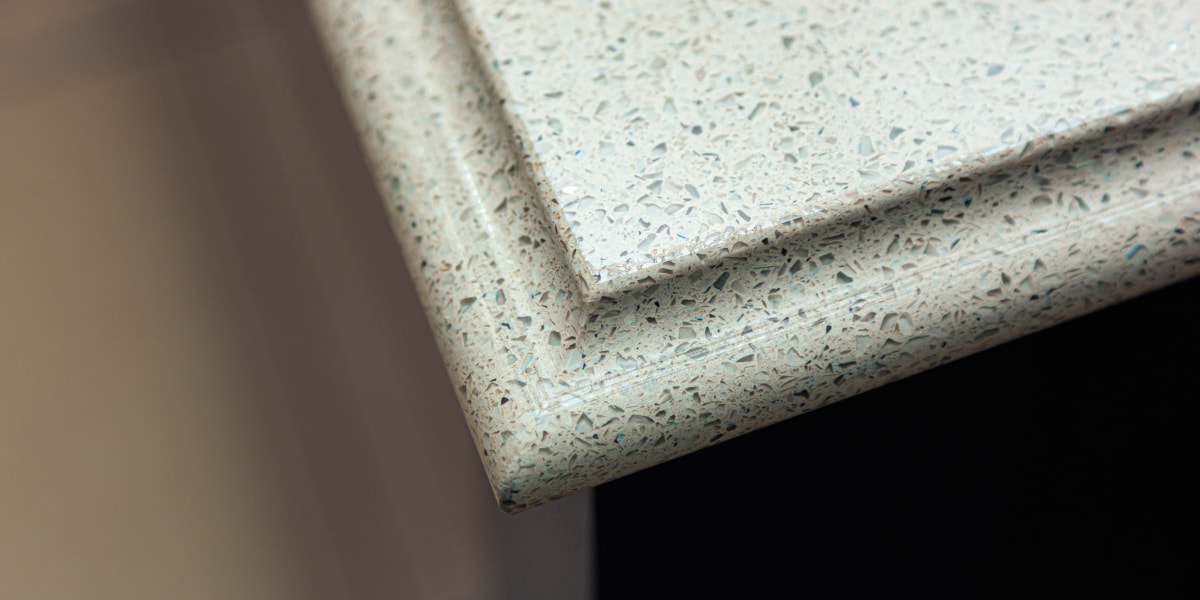Published on December 23rd, 2022
Last updated on February 3rd, 2023
How To Paint Concrete Floors? Tip Guide That Every Beginner Must Know!
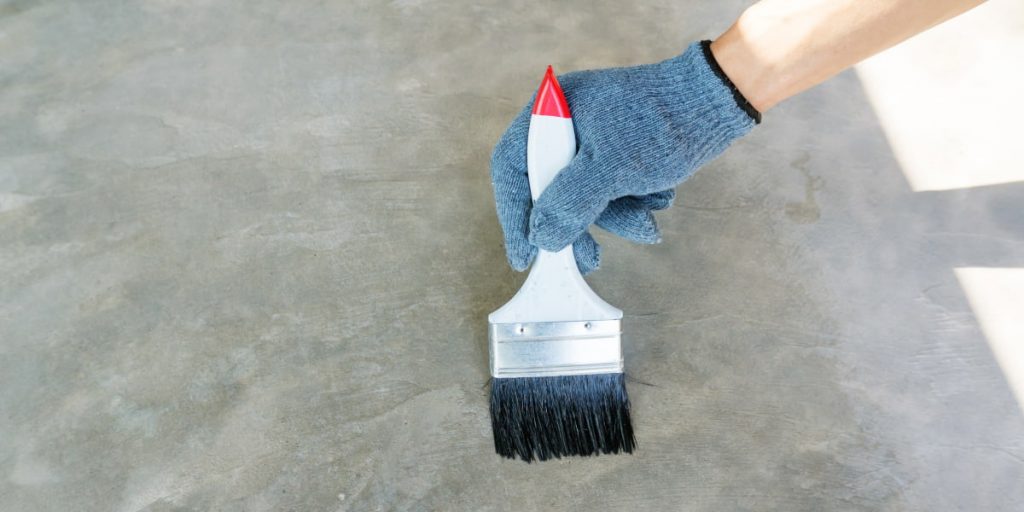
Concrete floors are durable and strong. That is why they are often used in industrial facilities and production halls. Also, people often use concrete floors in the construction of private workshops. But, it has a weak point – the top layer, so it is vital to know how to paint concrete floors. Because if you damage it, the functional and aesthetic properties of the surface are at risk. Many factors can damage the top layer:
- moisture;
- sudden temperature changes;
- chemicals;
- intensive use loads.
As a result, the concrete will begin to dust. Today, we can use the simplest and cheapest option to protect the coating and its decoration. It is painting cement floors with special paints.
It is preferable to leave the floor unpainted, as with any concrete substrate. But even a material as durable as concrete will wear out over time. You may see chips and other mechanical damage. That’s why painting a concrete floor is so necessary. It will serve as a protective layer and decorate the room. It is what our article will focus on.
Why Paint the Concrete Floor Basement?
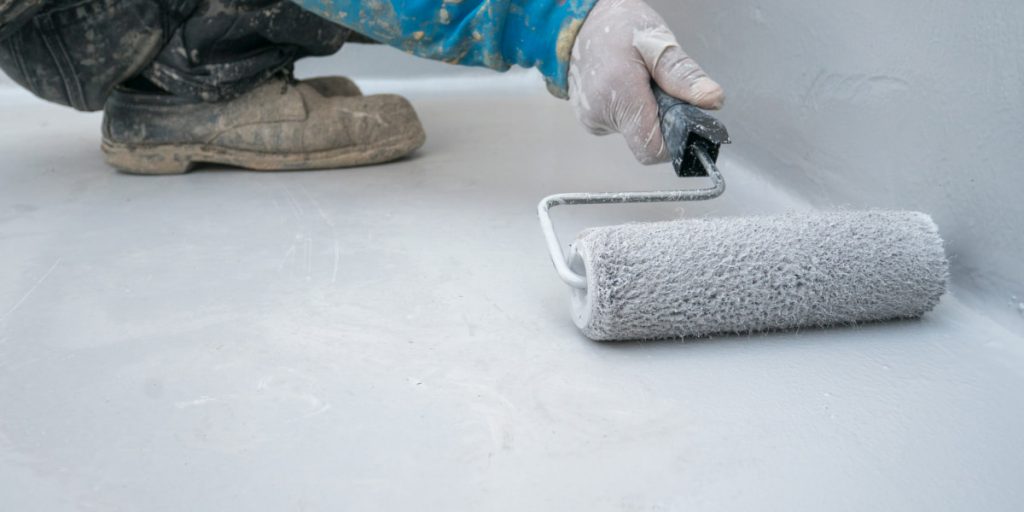
You can reinforce the concrete screed with a layer of decorative material:
- ceramic tiles;
- laminate.
But in commercial or industrial premises, such protection is ineffective. Or its installation is not cost-effective. Thus, to protect surfaces in garages or barns, you need to paint concrete floors. Painting protects against physical and chemical influences.
But is it so essential to protect concrete? Cement-based screed is quite durable, but it has a porous structure. It is vital to paint the concrete floor basement. Because over time, the screed will begin to deteriorate and lose its integrity.
The fracture occurs because the hardened cement mortar has:
- A porous structure in the mass. Concrete absorbs any water from the surface or the air in the room. As a result of temperature changes, the water in the pores:
- will change volume;
- destroy the screed from the inside out.
- Low resistance to weight and physical stresses on the surface. As a result of such loads, concrete will delaminate and dust.
What are the benefits of painting interior concrete floors?
As mentioned, any concrete surface requires external protection. But, as a rule, durable and resistant decorative materials are fairly expensive.
Concrete painting is the most cost-effective protection solution. Because it preserves the strength characteristics of the concrete. And also it performs the following necessary functions:
- provides an increase in the strength of the screed and, as a result, extends the life of the coating;
- minimizes the possibility of delamination or cracking;
- protects the concrete screed from abrasion;
- establishes a barrier against the effects of chemically active substances;
- increases antistatic properties of concrete.
By choosing the best way to paint a concrete floor, you can solve other operational issues:
- make the surface non-slip, reducing the risk of possible injury;
- simplify floor maintenance and cleaning;
- make the room more comfortable, modern paints have a vibrant color palette.
DIY Painted Concrete Floors: Technology
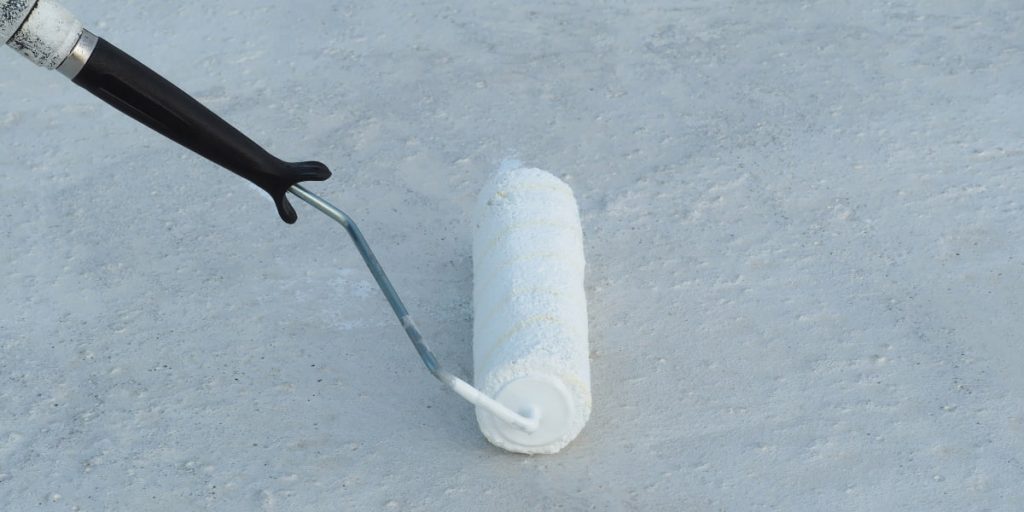
The stages of work are always the same. Although the conditions in the room may differ depending on the type of paint used. Before painting a concrete floor, let’s consider what steps you need to take.
In total, it is worth allocating 4 stages of the work:
- preparation, scraping the surface;
- primer or primer treatment;
- painting;
- drying.
Below you can read about them in more detail.
Preparation
In this step, you do the same steps as you would do with almost any concrete surface. Before you do anything with the screed, you need to:
- inspect;
- clean;
- restore.
To prepare the surface for painting cement floors, you must do the following work:
- If there is an old paint coating on the surface, you need to remove it. You can do it with a grinder or spatula. The quality of the prepared surface depends on the choice of tool. A spatula can add scratches to the concrete. A grinder can remove surface peeling as the paint, but there is a risk of noticeable depressions.
- Stains from chemicals: grease, oil, gasoline – clean up with a solvent, and degrease the surface.
- You should repair defects in the form of chips, cracks, small recesses or bulges. We recommend that you consider pouring a new leveling layer of low thickness. Do this if the screed has more than half of the damaged surface.
- After all restoration work, you need to clean the concrete of dirt and dust. It is really essential step when you paint a concrete floor basement. We also recommend washing the screed surface with a soapy solution. You can use it as an extra degreasing method.
After the floor is dry, flat, and clean, treat it with primer.
Primer
Priming concrete can be the final step. We recommend using quality primers of deep penetration and applying them in several layers. Since such protection will be of the same quality as the paint coating. As a rule, people choose this method to save money. Remember that high-quality primers in several layers are not always cheaper than painting.
Primer treatment can increase concrete adhesion and reduce paint’s degree of absorption. Before you treat the floor with primer, you should decide how to paint the concrete floor basement. Choose the type of primer depending on the forming substance of the paint.
Application of the primer
There is nothing complicated about treating concrete with primer with your own hands. Carry out the work of applying the composition on the concrete:
- at a room temperature of more than 50 ℃;
- at a relative humidity of less than 85%.
It is essential to observe the following rules.
You have to apply the solution:
- abundantly;
- in several layers (at least two);
- over the entire surface, avoiding “white” spots.
Before you apply primer, carefully read the instructions on the label. Some primers need more solvent.
- You can add quartz sand to the primer solution to increase the roughness of the surface. The allowable amount of inclusion is no more than 10% of the initial volume.
- The composition is applied to the surface with a roller or sprayer. We recommend treating the floor around the room’s perimeter on the walls with a brush. It will provide a better degree of protection.
Popular types of primers
Before properly painting the interior concrete floor, choose a suitable primer composition.
The most commonly used primers are of 3 types:
| Name | Description |
| Polyurethane | You can use it in combination with polyurethane paint. The composition is easy to apply. It also requires no special preparation before application. Operational benefits from the use of this type of primer:fills small sinks and voids;improves the adhesion of concrete;fast drying time;protects against the action of active chemicals.Treatment of concrete screed with polyurethane primer reduces the amount of paint required.The disadvantages of using this primer should include restriction before the following works. You can apply paint on concrete treated with polyurethane primer after 12 hours. |
| Epoxy | You can use this compound before painting cement floors with an epoxy-based paint. You also may use it as an independent protective coating. Epoxy compositions form a film on the surface. They do not penetrate into the pores of the concrete. This is their main difference from polyurethane primers. As a result of treatment, the screed becomes:waterproof;resistant to any chemicals;not susceptible to the action of UV light;very durable and poorly abrasion.The disadvantage of epoxy primer is the short lifetime of the finished composition. At the same time, most epoxy solutions are two-component. |
| Latex | Masters do not use this primer as a stand-alone protective coating. So you should use it for different types of paints. This treatment strengthens the old concrete screed, reducing the degree of delamination.Latex composition is environmentally friendly. Creates a film on the surface, like epoxy, but sets the upper layers of concrete. It dries very fast. |
Drying
We deliberately skipped the stage of painting a concrete floor. So we will talk about it in detail below. We must note that all the work to paint the concrete surface should not be enough. You need to create the perfect conditions for the paint to dry.
For the coating to dry evenly:
- The temperature inside the room must be in the range of 18 – 24℃;
- A relative humidity of less than 80%.
Also, the concrete quality is important to the drying conditions of the paint coating. The drying time on old concrete usually corresponds to the time on the paint label. If you process the fresh screed, the total drying time will increase.
You can use the painted floor after 2 days, but the full weight load is better to postpone until later.
What Paint to Use on the Concrete Floor?
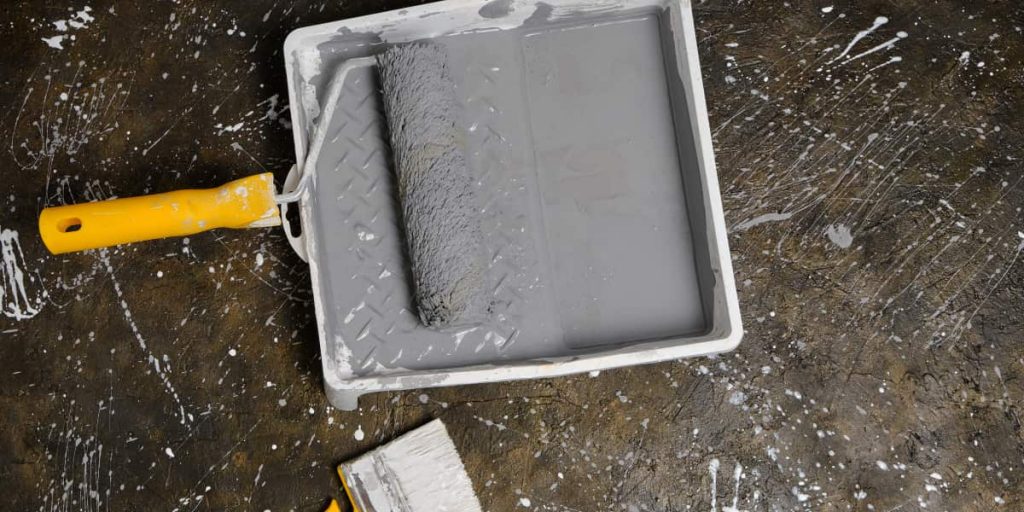
So, we’ve dealt with whether you can paint a concrete floor. We also described how to prepare for applying the cement coating. It is worth taking a closer look at the paint options for concrete surfaces. Besides, we will talk about the technology of their application. We can distinguish three main compositions for painting interior concrete floor:
- polyurethane;
- epoxy;
- acrylic.
The choice of material for painting is taken into account:
- the price of the coating material;
- the peculiarities of the surface;
- the functional purpose of the room.
Polyurethane paint
Polyurethane enamel is a two-component compound. We think that it is one of the best ways to paint concrete floors. It is suitable for work inside the building and covering exterior concrete surfaces. Concrete painted with polyurethane enamel has a smooth glossy surface.
You can notice the following advantages of the coating:
- excellent covering power;
- economical in use;
- resistance of the coating to chemical attack.
Before applying to the screed, thoroughly mix the enamel’s main component. Then add the second component. After that, remix the composition until it is homogeneous.
You have to paint the concrete floor basement in two layers:
- The first layer is thin and applied without any streaks;
- The second coat you apply more densely at intervals of no more than 24 hours.
The drying time of the paint is 2 weeks. The coating will gain maximum chemical resistance and final strength during this period. You can move over the coating already after two days. You can do it to learn more about the technology of applying polyurethane paint.
Paintwork coatings based on epoxy resins
This coating is highly durable and long-lasting. Concrete, painted with epoxy, gets a beautiful appearance. The coating is not afraid of high humidity. It is inert to chemically active substances, technical liquids, and flammable oils.
Epoxy has a high degree of adhesion to concrete. It also does not change color over time or when exposed to UV light. It has proven to be excellent for painting cement floors in:
- production halls;
- repair shops;
- hangars;
- outdoor areas.
If you apply the material to undried concrete, the quality of the screed becomes better.
But this type of paint still has several disadvantages:
- This paint and polyurethane one is a two-component mix. And the mixing proportions must be strictly observed.
- It can be challenging to change the color of the surface when painting a concrete floor one more time. So when choosing the color of the floor, consider that you will have to use it for a very long time.
- Another disadvantage is the time it takes to finish the surface. The concrete screed needs to be pretreated with an epoxy-based primer. As a primer, you can use paint diluted with water. After the preparatory layer dries, you paint the surface in 2 layers. The technical interval is no more than one day.
Concrete painted with epoxy-based paint is ready for use after seven days. It is the amount of time required for the resin to polymerize fully.
Acrylate-based paints
Acrylic compositions are paints with various polymer additives. The best way to paint a concrete floor with such material will create a protective polymer film surface.
Acrylic, as a part of the material, provides durability and resistance to abrasion. The paint has excellent adhesion properties and adheres perfectly even to the smoothest concrete screeds. The surface is durable and moisture-resistant.
Remarkably, the paint dries very fast:
- You can use the surface after 12 – 14 hours;
- the surface is ready in a maximum of 72 hours.
Using this type of paint, different types of surfaces can be created:
- matte;
- glossy;
- semi-matte.
The main advantages of acrylic compounds over other paints:
- It is odorless;
- they are water-dispersible;
- you can dilute the composition with plain water or a special solvent;
- fast drying time even with a significant thickness of the layer.
Bottom Line
Painting concrete floors is a reasonably simple process, technically. It takes more time to carry out activities to prepare the concrete for applying paint. But all stages of the process can be done with your own hands, without the involvement of highly qualified professionals.
FAQ
How soon after screeding can I paint concrete?
If you are going to paint a freshly poured screed, you should immediately begin with the full setting. It will come in 4 weeks. You can apply paint to new concrete from the time of first curing after 7 days.
How to paint the concrete floor basement outside?
If you have thought about how to paint a concrete floor outside, the painting technology is not much different from the work indoors. You just need to wait for suitable weather conditions. Most paint compositions on artificial stone suit interior and exterior surfaces.
Can I apply acrylic over another paint on concrete?
You cannot apply acrylic over a concrete floor that was previously painted with polyurethane or epoxy enamel. We recommend removing the old paint layer beforehand.
Why primer the floor before painting cement floors?
Primers help reliably cover stains, repaint the surface to a lighter color, avoid uneven paint and get a perfect finish, improve paint adhesion (bonding) to various materials, increase the paint layer’s longevity, and protect surfaces from mildew.


